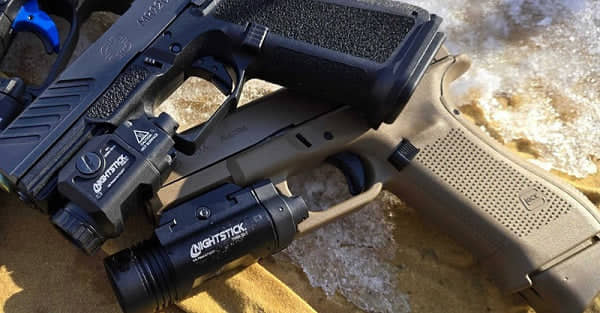Hunting after dawn or before dusk brings its own set of challenges. One of the biggest is simply seeing what you’re doing, judging your surroundings, and making a safe, clean shot. That’s where tactical lighting has stepped in as a game-changer in hunting gear.
In recent years, compact and high-output weapons flashlights have become essential for hunters who track or shoot in low-light conditions. They’re no longer limited to tactical or law-enforcement setups — many hunters now use them to improve visibility, identify targets faster, and make each shot count.
Table of Contents
The Role of Lighting in Hunting Environments
Early morning twilight, dense woods, deep shadows, or low-light situations all reduce visual clarity. Without proper lighting, even familiar terrain can become disorienting. Poor light affects your ability to see:
- what’s ahead (terrain, branches, obstacles),
- what you’re holding (weapon, gear, sight plane), and
- your target and back-drop.
Using a strong, well-placed light helps mitigate those risks. It boosts your awareness of the environment and allows you to settle into a stable, controlled position before taking aim.
How Tactical Lighting Helps Accuracy
When your target appears in less-than-ideal light, a tactical light offers three core benefits:
Improved sight alignment
When you can clearly see your aiming point, you reduce guess-work. Whether using iron sights or optics, a tactical light shining down the barrel or alongside allows you to pick up the dot, the fibre-optic, or reticle faster and hold steady.
Faster target acquisition
In low light, your eyes need to adjust and your brain needs more time to interpret what you see. A tactical light reduces that “lag.” You identify the game, its posture, direction, and distance quicker, which helps you decide whether to engage or wait.
Assured shot placement
When everything is dim, you may use a “feel” shot or rush because you’re uncomfortable. A good tactical light gives you confidence: you know you’re seeing your target clearly, you know your surroundings, and you can take your time to ensure a clean, ethical hit.
How Tactical Lighting Boosts Awareness
Beyond accuracy, awareness is a major benefit of this kind of gear. Here are some ways tactical lighting enhances situational awareness while hunting:
Detecting movement and hazards
Shining a light across brush or along game trails reveals subtle movements that eyes in twilight might miss. That could be a game animal, or it could be a hazardous branch, terrain drop-off, or other obstacle.
Reading your environment
Hunting is rarely static. The wind changes, the game moves, and shadows shift. Being able to glance around your immediate zone with a tactical light allows you to monitor these changes and adjust accordingly — stance, cover, aim point.
Communicating or signalling when needed
In team hunts or when working with a spotter, a tactical light can be used to signal or mark a lane of fire safely. While not the primary use, it adds an extra layer of coordination when used consciously.
Practical Steps to Use Tactical Lighting Effectively
Here’s a step-by-step breakdown of how to integrate and use tactical lighting in your hunting routine:
Step 1: Choose the right light setup
Pick a tactical light that can mount securely on your rifle or shotgun and withstand the recoil. Look for one with adjustable brightness (so you can dial back when full blast would spook game) and a reliable activation switch (easy to hit but not prone to accidental activation).
Step 2: Practice mounting and aiming with the light
Before you head into the field, practice with your weapon, mounted light, and your optics or sights. Work on finding your zero and ensuring the beam does not interfere with your sight plane. Comfort and ease here translate to speed in the real hunt.
Step 3: Use the light to scan before committing
When you reach shooting position or an area of interest, use the light to sweep the zone. Identify your target, ensure there are no hazards or non-targets in the backdrop, and confirm your line of fire is clear. Only then bring up your aim and take your shot.
Step 4: Adjust brightness for the situation
In total darkness you may need near-maximum output. But when there’s residual light or moonlight, a low-power setting may suffice and is less likely to spook the game. Always think about preserving your night vision and the game’s awareness of you.
Step 5: Maintain proper behaviour after the shot
Once your shot is off, continue to use the light to assess what happened: track your target if necessary, verify where it went down, and check the zone for safety. Having the beam already mounted and ready means you don’t fumble at the key moment.
Key Considerations & Ethical Notes
Using a tactical light does add weight and complexity to your gear, so make sure you’re comfortable carrying it for the duration of your hunt. Always check regulations — in some regions, using artificial light while hunting is restricted or banned. Compliance is essential.
Also, don’t rely solely on a light to compensate for poor shot placement or practice. The weapons flashlight is a supportive tool meant to enhance accuracy and awareness, not replace core skills.
Ethically, every hunter’s goal is a clean, one-shot-one-kill scenario. Tactical lighting supports that outcome by improving visibility and reducing uncertainty. But proficiency, range estimation, and discipline remain your best assets.
Summary
The evolution of hunting gear has made tactical lighting an indispensable part of modern setups. By improving sight alignment, speeding target acquisition, and boosting environmental awareness, a well-used light enhances both accuracy and safety.
If you haven’t yet tried incorporating one, start small — practise at dusk, learn your light’s angles, and adjust brightness for comfort. Over time, you’ll see how tactical lighting (and a dependable weapons flashlight) can make twilight hunting clearer, safer, and more precise.

